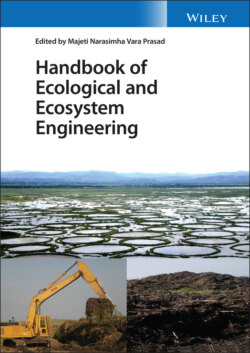Читать книгу Handbook of Ecological and Ecosystem Engineering - Группа авторов - Страница 27
2.2.5 Dryness
ОглавлениеDescription of the marginality factor: Dryness is a severe water stress that induces changes in the maturity time of plants and losses in their biomass yields, causing leaf senescence and increasing the stem/leaf ratio as well the translocation of nutrients to the roots [92, 93]. Dryness induces the closure of stomata, affecting the photosynthetic process and leading to less water loss through transpiration [94, 95]. Dryness can also be seen as the ratio between annual precipitation and potential evapotranspiration in a particular area, causing marginality [61]. When dry conditions develop in soil, its surface becomes dry and hard, making root penetration difficult. However, in some soils, the deepest layers can contain enough moisture for plant growth. Even if some roots manage to penetrate these deeper layers, deleterious effects should be expected to occur in the more superficial soil layers [96].
Revitalization by ecosystem engineering: In dry conditions, cytokinin concentrations on plants decrease, stoma closes, and growth is redirected from the aerial components of the plants to the underground ones. The inoculation of plants with cytokinin‐producing bacteria in water deficit conditions can be an efficient approach to overcome dryness [97]. Drought tolerance of the bioenergy crop giant reed (A. donax L.) is high, and it is well‐suited to warm, temperate, and semi‐arid environments with high temperatures and prolonged summer dryness [98]. The same authors pointed out Miscanthus spp., switchgrass, and other fast‐growing, fast‐yielding energy crops exhibited high tolerance to drought [65]. However, during the establishment phase of these perennials, it is essential to avoid drought. From the second year onward, drought tolerance increases since rhizomes are already established, reaching water sources from deeper soil horizons [61]. Despite this, the productivity of these crops can be affected by drought.
Techniques such as mutagenesis have been identified as valid strategies for increasing the genetic diversity of giant reed, increasing its performance under dry soil conditions [99]. Moreover, giant reed can maintain its photosynthetic capacity and leaf growth to minimize the stress caused by drought [100]. In fact, giant reed can change its water sources depending on water availability, maximize water uptake efficiency, and satisfy evapotranspirative demands [101, 102]. When water is scarce, the giant reed species can improve the efficiency of water use and maintain high productivity. This fact indicates that the species can grow under conditions of moderate irrigation during periods of drought.
Saccharum spontaneum spp. aegyptiacum is another potential bioenergy crop species that produces high biomass yields while tolerating environments characterized by drought stress, high temperatures, and high vapor pressure deficit [94]. It is a C4 plant with a rapid growth rate, few or no natural enemies, and very active assimilation rates during drought‐stress periods, and it can use water very efficiently [103]. Saccharum spontaneum spp. aegyptiacum is so well adapted to drought conditions in Southern Europe that it displays biomass yields even higher than Miscanthus spp. and A. donax grown in the same experimental conditions and under well‐watered, rainfed conditions [104].
Reed canary grass shows high plasticity and is one of the best candidates for most marginal land revitalization. It can be distributed in and dominate various habitats, including wetlands and riparian zones; and in a cool temperature climate, it can withstand flooding for long periods and exhibits excellent drought tolerance [98]. The energy crops perennial ryegrass (Lolium perenne L.), Panicum spp., and Sorghum spp. are also well adapted and resistant to drought conditions [105, 106].
